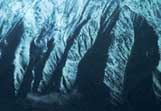
Film Footage
In shooting the small amount of available film, I edited in the camera rigorously. I had very little footage to use, and none to waste. I would sometimes divide the 3 minutes-50 feet-into different segments to maximize the documentation. My goal in capturing anything on film was to serve as an aide-memoire, a memory aid, to note down the way people played their instruments, danced, or constructed contexts for entertainment activities.
Footage shot from planes or at a distance from unapproachable settlements was meant to sketch out the cultural ecology. Though it is jerky due to those limitations (there was no steady-cam technology then), I have included it. I shot only using available light. The total amount of film that captures the musical life of Afghanistan before 1978 must be extremely small, so nothing is really superfluous.
In 1982, I transferred most of the super8 footage onto 3/4" video, with crudely-made intertitles, to serve as a supplement for my book on the Afghan North. In 2001, this moved to mini-DV, and that version went to this website.
In this last transfer, I thought of "improving" aspects of the footage through digital editing. A brief attempt, using Final Cut Pro, showed how difficult this would be, in terms of man-hours for tiny decisions on a shot-by-shot basis. It also made me think about what could be gained, and what would be lost. Adjusting for a blurred shot means rebuilding the shot. Changing lighting or color alters what the camera absorbed of its surroundings. In the end, it became clear that the "aura" of the original footage, profoundly stamped by the place and time it was fixed on film, should simply be left as is, to hover in some phenomenological space between ethnography and reality as mediated by the Canon's capabilities. I am grateful to a number of colleagues, including John Baily and Victor Burgin, for thinking through the issues at a seminar in London in 2002.
There is a strange tension in the video version you can watch here. Silent super8 was mutely eloquent. You could really take in the visual detail because there was no competing, if compatible, layer of sound. The sound backing I put on in 1982 is somewhat suitable, in that wherever possible, I used the performance that was taped when the film was shot. But I could not resist adding atmospherics, as in the opening mountain pan, or the partridge fights. These are arbitrarily selected. To get the most "documentary" effect, you might want to turn off the sound when watching the clips.
The contrast between the "blind" footage I created with my tape recorder and the silent scenes of life and music enables some reflection on "schizophonia," a term invented by R. Murray Schafer and popularized in ethnomusicology by Steven Feld to reference the disjunct between sound in its original, field context and the way we listen to it in another space and time. Our total immersion in video today has in some sense papered over the cracks by blurring real-life, staged, and fantasy scenarios, creating sight-and-sound spectaculars we absorb without consideration or categorization. By contrast, my ethnographic harvesting of visual and sonic information parallels the limitations of the Afghan setting itself, with its scarcity of both live and mediated music and insistence of maximum privacy. The walled compound, the rationed time of market days, and the strict gender segregation created an economy of sound and image that in some way matches my limited resources and frugal filming.
|





